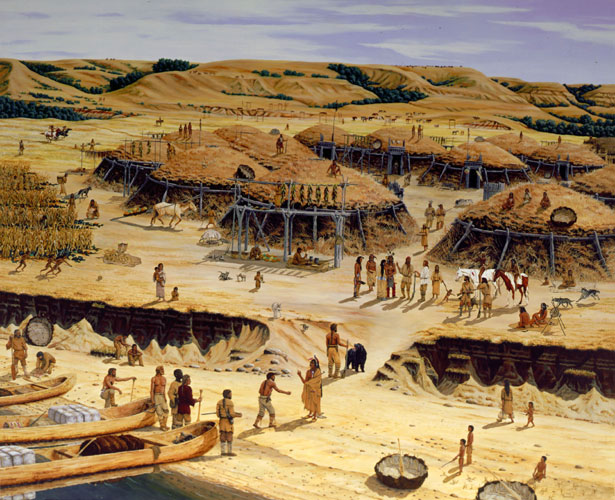We’ve launched a new web portal! Visit findhistory.nd.gov to search our collections.
Due to a road closure, the Killdeer Mountain Battlefield State Historic Site is temporarily closed.
Before Euro-American settlement of the Northern Plains began in the 19th Century, the land had been occupied for many centuries. Archeological investigations document the presence of big game hunting cultures after the retreat of the continental glaciers about 10,000 years ago and later settlements of both hunting and gathering and farming peoples dating ca. 2000 B.C. to 1860. When the first white explorers arrived, distinct Indian groups existed in what is now North Dakota. These included the Dakota or Lakota nation (called "Sioux", or enemies by those who feared them), Assiniboine, Cheyenne, Mandan, Hidatsa, and Arikara. Groups of Chippewa (or Ojibway) moved into the northern Red River valley around 1800, and Cree, Blackfeet, and Crow frequented the western buffalo ranges.
These peoples represented two different adaptations to the plains environment. Nomadic groups depended primarily upon vast herds of American Bison for the necessities of life. When the horse was brought to the Northern Plains in the 18th Century, the lives of the Dakota, Assiniboine, and Cheyenne changed dramatically. These bands quickly adapted to the horse, and the new mobility enabled them to hunt with ease and consequently to live better than ever before. The horse became a hallmark of Plains cultures, and the images of these mounted Indians bequeathed a romantic image of power and strength that has survived in story, films, and songs.
In contrast, the sedentary Mandan, Hidatsa, and Arikara lived in relatively permanent earthlodges near the Missouri River and supplemented produce from extensive gardens with hunting; their fortified villages became commercial 
Lewis and Clark Entering Black Cat Village
Painting by Andrew Knudson
SHSND #2003.9.1centers that evolved into trading hubs during the fur trade of the 18th and 19th centuries.
Indians and Euro-Americans came into contact during the 18th Century. The first recorded visitor was La Verendrye, a French explorer who reached the Missouri River from Canada in 1738 while searching for a water route to the Pacific Ocean. Others followed, including La Verendrye's sons in 1742. However, most contact resulted from the Canadian fur trade until Meriwether Lewis and William Clark led the American "voyage of discovery" up the Missouri from St, Louis in 1804.
Address:
612 East Boulevard Ave.
Bismarck, North Dakota 58505
Get Directions
Hours:
State Museum and Store: 8 a.m. - 5 p.m. M-F; Sat. & Sun. 10 a.m. - 5 p.m.
We are closed New Year's Day, Easter, Thanksgiving Day, and Christmas Day. We are closed at noon Christmas Eve if it falls on Mon.-Thurs. and are closed all day if it falls on Fri.-Sun.
State Archives: 8 a.m. - 4:30 p.m. M-F, except state holidays; 2nd Sat. of each month, 10 a.m. - 4:30 p.m. Appointments are recommended. To schedule an appointment, please contact us at 701.328.2091 or archives@nd.gov.
State Historical Society offices: 8 a.m. - 5 p.m. M-F, except state holidays.
Contact Us:
phone: 701.328.2666
email: history@nd.gov
Social Media:
See all social media accounts